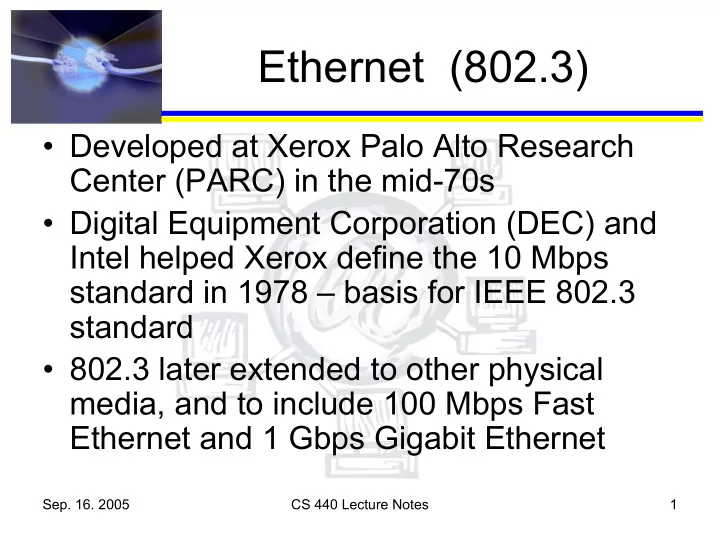

Ethernet (802.3) • Developed at Xerox Palo Alto Research Center (PARC) in the mid-70s • Digital Equipment Corporation (DEC) and Intel helped Xerox define the 10 Mbps standard in 1978 – basis for IEEE 802.3 standard • 802.3 later extended to other physical media, and to include 100 Mbps Fast Ethernet and 1 Gbps Gigabit Ethernet Sep. 16. 2005 CS 440 Lecture Notes 1
CSMA/CD • Ethernet based on Carrier Sense Multiple Access with Collision Detect technology – Multiple nodes share the link – wire serves as a bus – Carrier sense means that every node can distinguish between idle and active link – Collision detect means that a node listens as it transmits and can tell if its transmission has “collided” with a transmission by another node Sep. 16. 2005 CS 440 Lecture Notes 2
Physical Medium • Ethernet segment is a length of coaxial cable up to 500 m long • Impedance is 50 Ω • Taps are at least 2.5 m apart • Transceiver senses carrier, drives signal onto line, simultaneously receives signal from line Sep. 16. 2005 CS 440 Lecture Notes 3
Physical Medium (cont.) • Transceiver connects to Ethernet adaptor that implements control logic • Multiple segments can be joined by repeaters . Repeater regenerates digital signal – No more than 4 repeaters between any two hosts, so max separation is 2,500 m • Segment ends in terminator that prevents reflection of signal back up cable Sep. 16. 2005 CS 440 Lecture Notes 4
Physical Medium (cont.) • Maximum of 1,024 hosts • Manchester encoding used on wire • Original medium called 10Base5, or thick-net . Other media introduced later: – 10Base2 ( thin-net ) – 200 m – 10BaseT (twisted pair, Cat5) - 100 m 10BaseT cable does not use taps into cable; requires a hub • Regardless of medium and number of segments or hubs, all nodes on network see the wire as a single link Sep. 16. 2005 CS 440 Lecture Notes 5
Physical Medium (cont.) • Sep. 16. 2005 CS 440 Lecture Notes 6
Access Protocol • MAC ( media access control ) algorithm controls access to link • Frame format: 64 48 48 16 368 - 12,000 bits (46 - 1,500 bytes) 32 Dest Src Type / Preamble Body … CRC Addr Addr Length – Preamble is alternating 0s and 1s; allows receiver to sync on signal – Type flag identifies higher level protocol; in 802.3, this is length. Ethernet type values all > 1500, so receiver can handle both protocols Sep. 16. 2005 CS 440 Lecture Notes 7
MAC Addresses • 48-bit MAC address is unique (or supposed to be) for every Ethernet adapter in the world – Address blocks allocated to manufacturers • Address typically displayed as six two-digit hex values; i.e. 00:50:2C:0A:0B:EE • Special address FF:FF:FF:FF:FF:FF is broadcast address • Any other address with first bit 1 is a multicast address Sep. 16. 2005 CS 440 Lecture Notes 8
MAC Addresses (cont.) • Multicast addresses are used to send to some subset of nodes – each adapter must be told which multicast addresses it should recognize • Some adapters can be placed into promiscuous mode, which will receive all frames regardless of address Sep. 16. 2005 CS 440 Lecture Notes 9
Transmitter Algorithm • When adapter has data to send and line is idle, it transmits immediately – 1500 byte max data size limits time it can occupy link • When adapter has data to send and line is busy, it waits until line is idle, then transmits immediately – Called a 1-persistent algorithm, since there is a 100% chance it will transmit as soon as line is idle Sep. 16. 2005 CS 440 Lecture Notes 10
Collisions • Alternative is p-persistent protocol, where 0 < p < 1 – This decreases chance that two nodes will transmit at the same time – Ethernet just uses 1-persistence • Collision occurs if two nodes transmit at the same time – Any adapter that detects a collision sends a 32-bit jamming sequence and stops sending Sep. 16. 2005 CS 440 Lecture Notes 11
Collisions (cont.) – Shortest frame thus 64 bit preamble and 32 bit jamming sequence. • Longest time it can take for signal from one host to reach another is 512 bits – this is based on bit width, propagation speed of signal in wire and maximum length of network (2500 m) – This is why there is a minimum data length for packet; sender must pad shorter messages Sep. 16. 2005 CS 440 Lecture Notes 12
Collisions (cont.) • After sender detects a collision and stops, it waits either 0 or 51.2 μ s (chosen randomly), then retransmits if link is idle • If transmission fails, adapter increases the wait time – multiplies by 51.2 μ s by a random number from 0 to 3 • Next failure multiplies by 0 to 7 • Exponential backoff – n th try multiplies by 0 to 2 n • Retry up to 16 times, but n capped at 10 Sep. 16. 2005 CS 440 Lecture Notes 13
Empirical Performance • Because of possibility for collisions, Ethernet works best if not heavily loaded – Utilization over 30% is heavy • Ethernet network is simple, easy to administer, inexpensive Sep. 16. 2005 CS 440 Lecture Notes 14
Recommend
More recommend